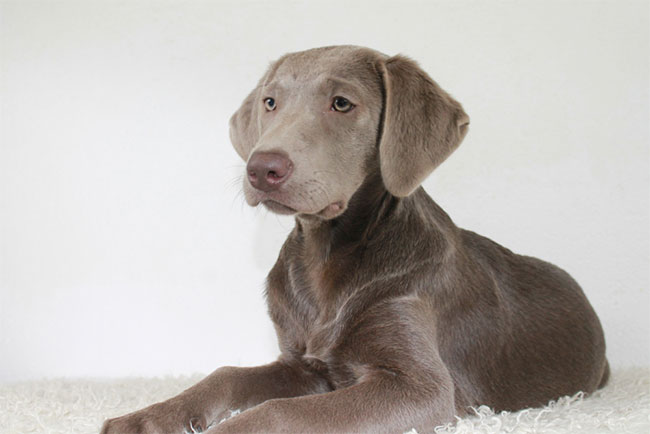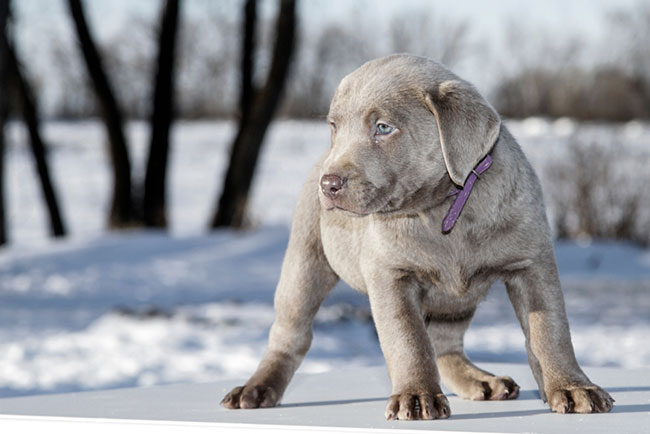Silver Labrador Retrievers have become popular because of their unique silver-gray coat color. However, this color has caused controversy among breeders and dog lovers. Some people question the breed’s authenticity, while others are concerned about their health. In this article, we will explore the facts about Silver Labs, including their personality, exercise needs, and potential health risks associated with their breeding. We will try to provide you with clear and simple information to help you decide if a Silver Lab is the right choice for you. So, let’s dive into the debate and discover the truth about Silver Labrador Retrievers.
Genetics About Coat Color In Labrador Retrievers
Labrador Retrievers come in three coat colors: black, yellow, and chocolate. The inheritance of coat color is controlled by multiple genes and is quite complex.
The gene that is primarily responsible for determining the black or chocolate coat color in Labradors is called the B gene. There are two versions of this gene, B and b. The B gene is dominant and produces black pigment, while the b gene is recessive and produces chocolate pigment. Therefore, a dog can have a black coat either by inheriting a B gene from both parents (BB) or from one parent (Bb). A dog will only have a chocolate coat if it inherits two copies of the recessive b gene (bb).
The gene responsible for determining the yellow coat color in Labradors is called the E gene. There are three versions of this gene: E, e1, and e2. The E gene is dominant and produces black or chocolate pigment, while the e1 and e2 genes are recessive and produce yellow pigment. Therefore, a dog can have a yellow coat either by inheriting two copies of the recessive e1 gene (ee1) or two copies of the recessive e2 gene (ee2). A dog will have a black or chocolate coat if it inherits at least one copy of the dominant E gene (Ee, EE).
Here is a table showing the possible coat color outcomes based on the genotypes of the parents:
| Sire (Father) | Dam (Mother) | Possible Offspring |
| BBEE or BbEE or BBEe or BbEe | BBEE or BbEE or BBEe or BbEe | All Black (BBEE, BbEE, BBEe, BbEe) |
| BBee or Bbee | BBEE or BbEE or BBEe or BbEe | 50% Black (BBEE, BbEE, BBEe, BbEe) and 50% Yellow (Bbee, bbee) |
| bbEE or bbEe | BBEE or BbEE or BBEe or BbEe | 50% Black (BBEE, BbEE, BBEe, BbEe) and 50% Chocolate (bbEE, bbEe) |
| bbee | BBEE or BbEE or BBee or BbEe or bbEE or bbEe | 50% Yellow (Bbee, bbee) and 50% Chocolate (bbEE, bbEe) |
Note: The above table assumes that there are no other genes or factors influencing coat color inheritance, and that the parents are purebred Labradors.
The “silver” coat color in Labrador Retrievers is actually a variation of the chocolate color. Silver Labs have a diluted chocolate coat color due to a specific gene variant called the “dilute” or “dd” gene. This gene causes a dilution of the brown pigment, resulting in a grayish or silver color.
However, it is important to note that the silver color is not recognized as an official color by the American Kennel Club (AKC) or the UK Kennel Club. The AKC only recognizes three colors for Labradors: black, yellow, and chocolate. Therefore, reputable breeders should not intentionally breed for silver coat color in Labradors.
Additionally, there has been controversy surrounding the breeding of silver Labs due to concerns over genetic health issues and the potential for unethical breeding practices. Therefore, it is important for potential Labrador owners to do their research and only obtain a puppy from a reputable breeder who prioritizes the health and well-being of the dogs.
Information About Silver Labs

Silver Labrador Retrievers are a rare and unique breed of labrador, known for their striking silver-gray coat color. Despite their unconventional appearance, Silver Labs share many characteristics with other labradors. They are highly active, intelligent, and love to play, especially when it comes to water sports and the classic game of fetch.
These friendly dogs are also incredibly social and enjoy spending time with their owners and other animals. While they can be a bit clingy at times, their agreeable personality makes them an excellent choice for families looking for an affectionate pet.
It’s worth noting that while Silver Labs are not considered a true labrador color by some breed standards, they are still beloved by many and highly sought after. Some breeders suggest that their unusual color is the result of cross-breeding with Weimaraners, but this is a matter of debate. Additionally, while Silver Labs are not formally recognized by the American Kennel Club, they are often classified as Chocolate Labs due to the dilute gene that causes their silver coat color.
If you’re considering adding a Silver Labrador to your family, be prepared to pay a bit more than you would for a traditional colored labrador. Silver Lab puppies can cost anywhere from $800 to $1500, compared to the $500-$1000 price range for other colors. However, for those who appreciate their unique appearance and charming personality, the extra cost may be well worth it.
Are Silver Labrador Retrievers Purebred?
Silver Labrador Retrievers are not considered a separate breed from the traditional Labrador Retriever, which is recognized by major kennel clubs such as the American Kennel Club (AKC) and the United Kennel Club (UKC). The AKC and UKC only recognize three colors for Labrador Retrievers: black, yellow, and chocolate. The silver coloration is not recognized as an official color by these organizations.
Instead, silver Labs are considered a variation of the chocolate coloration due to a specific gene variant called the “dilute” or “dd” gene. This gene causes a dilution of the brown pigment, resulting in a grayish or silver color.
Therefore, silver Labs are purebred Labrador Retrievers with a unique coat color variation caused by a specific gene. However, responsible breeding practices should prioritize the health and well-being of the dogs, and reputable breeders should not intentionally breed for the silver coat color. It is also important for potential owners to research and obtain a Silver Lab from a reputable breeder who prioritizes the health and welfare of their dogs.
History of the Silver Labrador
Labrador Retrievers have been around since the 1800s, and they were initially bred to assist in fishing, hunting, and duck retrieving. However, over time, they gained popularity as household pets. While Silver Labs are a relatively new addition to the Labrador family, their exact origin remains somewhat of a mystery. Some believe they first appeared in 1917, while others think it was in the 1950s. Initially, they were not considered purebred Labradors by kennel clubs and breeders, but it is now known that their unique coat color is due to a recessive dilute gene pair. The origin of this gene is unknown, which has led to some controversy surrounding Silver Labs. Despite their uncertain history, they have become increasingly popular as active and loving companions.
Silver Lab Controversy

There is controversy surrounding Silver Labrador Retrievers due to concerns over the breeding practices used to produce the silver coat color.
Some breeders intentionally breed two chocolate Labs carrying the dilute gene to produce silver puppies, which can increase the risk of genetic health issues such as hip dysplasia and eye problems. Additionally, some breeders have been accused of misrepresenting silver Labs as a rare and exotic breed, charging higher prices for them and creating a market for unethical breeding practices.
The AKC and UKC do not recognize the silver coat color as a standard color for Labrador Retrievers and consider them to be a variation of the chocolate color. Some breeders who prioritize the health and well-being of their dogs will not intentionally breed for the silver coat color and will only breed chocolate Labs that do not carry the dilute gene.
It is important for potential owners to do their research and only obtain a Silver Lab from a reputable breeder who prioritizes the health and welfare of their dogs, regardless of coat color. Additionally, it is recommended to consider adopting from a shelter or rescue organization to provide a loving home for a dog in need.
Silver Labrador Facts
- Silver Labs may have striking blue eyes as puppies
- They are more prone to skin problems such as Color Dilution Alopecia than other Labradors
- They have an outgoing and social personality
- They are highly intelligent and easy to train
- They make loyal and obedient companions for active families or individuals
Silver Labrador Appearance
Silver Labradors are undeniably stunning dogs with a distinct silverish gray coat that immediately catches the eye. Their coat color is unique compared to the more common Black, Chocolate, and Yellow Labradors. Their eyes are a beautiful shade of yellow, which contrasts strikingly against the gray fur. As puppies, Silver Labs have blue eyes, which gradually change color as they grow older. Their eyes are framed by a relatively small black pupil, adding to their captivating appearance.
One of the most notable physical features of Silver Labs is their long floppy ears that rest flat on the sides of their heads. Their nose, which always seems to be in search of something to eat (or sniffing butts), tends to be brown in color. They have wide skulls and muscular builds, and their strong tails wag non-stop upon seeing their owners, indicating their love and excitement.
In terms of size, Silver Labs are a large-sized breed, with an average height range of 23.5 to 24.5 inches. Males tend to have a slightly bulkier build compared to females. On average, a fully-grown Silver Labrador weighs between 55 to 80 pounds, with females weighing between 45 to 70 pounds.
Silver Labs have a double coat that protects them against harsh weather. Their inner coat is denser and thicker than their outer coat, which is thin and short. The inner coat is also water-resistant, allowing Silver Labs to enjoy water sports for a long time without affecting their health. Their coat is smooth and shiny, making them a joy to pet.
While Silver Labs have many physical attributes that make them distinct from other Labradors, they also have a few potential health concerns. They are more prone to developing skin problems such as Color Dilution Alopecia than other Labradors. This condition can cause hair loss and skin irritation, so it’s essential to provide proper care and attention to their skin and coat.
Overall, Silver Labs are a striking and beautiful breed with a unique coat color that sets them apart from other Labradors. Their muscular build, floppy ears, and wagging tail make them a favorite among many dog lovers.
Silver Labrador Temperament and Personality

Silver Labradors are known for their friendly, affectionate, and caring personalities. They make excellent companions to their human families and have an unwavering loyalty towards them. These dogs are highly intelligent and are always eager to please their owners, making them easy to train.
Despite their high-spirited nature, Silver Labs remain child-like at heart and are known to lift the mood around the house by being jolly, goofy, and adored by absolutely everyone. They have an easy-going personality and enjoy every activity with their human family. They love to feel their owner’s touch, no matter what they are doing. Due to their attachment to their owners, they are prone to exhibiting signs of separation anxiety when left alone for too long.
Silver Labs are a social breed that thrives on attention and being around people. They are excellent friends of kids and are patient and gentle towards them. They can be their playmates for hours without getting tired. One of the best qualities of these dogs is that they get along really well with other dogs and pets. Silver Labs are not aggressive towards strangers and get excited at the sight of another human. They like to hang out with them and try to impress them with their coolness.
Silver Labs are not much of a barking breed, except when they are a little anxious. They also tend to chew upon objects due to anxiety. These dogs are an active breed, just like black and yellow labs, and need to stay stimulated mentally and physically to keep them away from destructive behaviors. They can be a little prone to nipping, so they do require a lot of attention.
If you enjoy outdoor adventures like hiking, then Silver Labs make extraordinary companions. These dogs are known for their energy and love for outdoor activities. They enjoy exploring new trails, playing fetch, and swimming. They are also excellent swimmers, thanks to their water-resistant double coat that protects them against harsh cold weather.
Silver Labs Health Care
Silver Labs are generally a healthy breed but are prone to some of the same health issues as other purebred Labs. One common issue that Silver Labs can face is joint problems, such as hip and elbow dysplasia. These issues can cause pain and lameness and may require surgery or ongoing treatment to manage.
Another health concern for Silver Labs, as well as other Labs, is their tendency to overeat. Labs are known to have a hearty appetite and can easily become overweight or obese, which can lead to other health issues such as diabetes, heart disease, and joint problems.
Two studies have shown that the average lifespan for a Labrador is between 11 and 12 years of age, which is fairly typical for a larger breed dog. However, Labs do have a higher rate of cancer compared to some other breeds, accounting for approximately 31% of all deaths.
Despite these potential health concerns, Labs are generally a healthy breed with a sturdy build that is free from some of the disabilities that can affect other purebred dogs. Regular exercise and a healthy diet can help keep your Silver Lab in good health and prevent some of these issues from developing.
One particular issue that owners of Silver Labs need to be aware of is the potential health problems associated with the coat color dilution gene. This gene is responsible for the distinctive silver color of Silver Labs but can also cause skin and coat problems such as Color Dilution Alopecia (CDA), which can lead to patchy hair loss and skin irritation. While not a life-threatening condition, CDA can be uncomfortable for the dog and require ongoing treatment to manage. Therefore, it is important to discuss any potential health concerns with your veterinarian and to stay up to date with regular check-ups and preventative care.
Grooming Requirements for Silver Labs
Grooming is an essential aspect of taking care of a pet. It helps keep them healthy, happy, and comfortable. Silver Labs are no exception to this rule. Here are some grooming requirements that every Silver Lab owner should know.
Brushing
Silver Labs shed a lot, and as a result, it is important to brush them daily to reduce shedding. Using coconut oil at least once a month can keep their coat neat, shiny, and soft. Gently massage the oil for about five minutes and then clean it with a towel.
Bathing
Bathing your Labrador Retriever once a month is adequate. Brush them before bathing and after bathing, and dry them properly once you’re done bathing them. Use lukewarm water and mild shampoo; it will keep their skin maintained. Most Labrador Retrievers don’t give you a hard time with bathing, so you can wash them on your own pretty easily.
Nail Trimming
Trim your Silver labs’ nails every two months. However, if you start noticing scratching of nails against the floor while running, walking, or jumping around, trim their nails immediately.
Ear Cleaning
Silver Labs’ adorable floppy ears need to be checked and cleaned frequently to prevent any potential infection. Always include ear cleaning in their grooming session.
Health Complications in Silver Labrador
Silver Labrador Retrievers are no exception when it comes to potential health complications. While they are generally a healthy breed, like all purebred dogs, they are prone to certain genetic health issues. Some of the most common health problems include hip and elbow dysplasia, which can cause pain and mobility issues in the joints. They are also prone to obesity, which can lead to a range of health issues, including joint problems, diabetes, and heart disease. Silver Labs may also be susceptible to certain eye conditions, such as cataracts and progressive retinal atrophy. When choosing a Silver Lab, it is essential to look for a reputable breeder who conducts health screenings on their breeding dogs to minimize the risk of genetic health issues.
Color Dilution Alopecia ( CDA)
Silver Labs are a beautiful and unique color variation of the classic Labrador Retriever breed. However, it is important to note that this color variation may carry a genetic predisposition to a condition known as Color Dilution Alopecia (CDA).
CDA is a hereditary skin condition that affects dilute-colored dogs, such as Silver Labs, Blue Doberman Pinschers, and fawn Great Danes. It is caused by a genetic mutation that affects the hair follicles, resulting in hair loss and skin irritation.
The symptoms of CDA usually appear in dogs between the ages of 6 months and 3 years. The first sign is usually patchy hair loss, which can progress to generalized hair loss across the dog’s body. The affected skin may become dry, scaly, and itchy, and can even become infected if left untreated.
Unfortunately, there is no cure for CDA, but the condition can be managed with proper treatment. Treatment may include regular medicated baths, topical creams, and supplements to promote healthy skin and coat. It is also important to maintain a healthy diet and keep the dog’s skin moisturized to help prevent further irritation.
If you are considering bringing a Silver Lab into your home, it is crucial to work with a reputable breeder who conducts genetic testing for CDA and other hereditary health conditions. By doing so, you can minimize the risk of your dog developing CDA and provide them with a happy and healthy life.
Hip and Elbow Dysplasia
Silver Labrador Retrievers are prone to hip and elbow dysplasia, which is a hereditary orthopedic condition. Dysplasia occurs when the joint doesn’t develop properly and becomes loose, leading to inflammation and arthritis. In some cases, dysplasia can cause pain and limping, and in severe cases, it can be debilitating. It is essential to ensure that the breeder you choose screens their breeding stock for hip and elbow dysplasia. It is recommended that you have your Silver Lab’s hips and elbows screened as soon as possible by a veterinarian, preferably one that is experienced in orthopedic issues. If dysplasia is detected, it’s important to work with your vet to manage the condition and ensure that your dog is as comfortable as possible.
Ear infections
Ear infections are a common health issue in Silver Labradors, just like in other breeds of dogs. Their floppy ears can trap moisture and wax, leading to bacterial or fungal infections. Signs of ear infections include head shaking, scratching at the ears, foul odor, redness, and discharge from the ears. To prevent ear infections, it’s important to regularly clean your Silver Lab’s ears with a veterinarian-recommended ear cleaner. Avoid using cotton swabs or other foreign objects, as they can push debris further into the ear canal, causing more harm than good. If you suspect an ear infection, take your dog to the vet immediately for proper diagnosis and treatment, which may include ear drops or antibiotics.
Exercise Requirements For Silver Labs

Silver Labs are energetic and active dogs that require daily exercise to maintain their physical and mental well-being. They should be given at least 60 minutes of exercise per day, but if your Lab is particularly active, it may require up to 1.5 hours of exercise.
There are many activities that can provide your Silver Lab with the necessary exercise, such as playing fetch, going on fast-paced walks, running, and being goofy. It is important to keep their exercise session varied and fun so that they stay interested and engaged.
In addition to physical exercise, Silver Labs also benefit from mental stimulation. Interactive and stimulating toys are a great way to keep your dog busy and entertained. These toys can also provide comfort when you have to leave them alone for a period of time.
It is important to dedicate one hour of your time daily to your Silver Lab and give them all your attention and love. Regular exercise and attention will not only keep your dog healthy but also strengthen the bond between you and your furry friend.
Silver Labrador Training
Training a Silver Lab is essential to ensure that your dog is well-behaved, obedient, and happy. With proper training, your Silver Lab can become a well-rounded and obedient member of your family.
There are several methods of training that you can use to train your Silver Lab, including positive reinforcement, clicker training, and leash training. Positive reinforcement is one of the most effective training methods and involves rewarding good behavior with treats, praise, or toys. Clicker training is another popular method that uses a clicker to mark desired behaviors and then rewards the dog with a treat.
Leash training is also important for your Silver Lab, as it teaches them to walk calmly on a leash without pulling or lunging. Consistency and patience are key when training your Silver Lab, and it is important to avoid punishment or negative reinforcement as this can be counterproductive and harm your dog’s trust and relationship with you.
There are many resources available to help you train your Silver Lab, including online tutorials, training books, and even professional dog trainers. One helpful resource is the YouTube video titled “Dog Training: Silver Lab” (link: https://www.youtube.com/watch?v=9QyydGrw1l8), which provides useful tips and techniques for training your Silver Lab.
Overall, training your Silver Lab is a rewarding experience that can strengthen the bond between you and your furry friend. With patience, consistency, and positive reinforcement, you can raise a well-behaved and obedient Silver Lab that brings joy and companionship to your life.
How Much is a Silver Lab?

It’s important to note that while Silver Labs are a unique and sought-after breed, they do tend to come with a higher price tag than other labrador colors. If you’re considering adding a Silver Lab puppy to your family, you can expect to pay anywhere from $800 to $1500 on average. However, it’s important to be wary of breeders who charge significantly more than this, as they may be taking advantage of the breed’s popularity to inflate prices. When searching for a reputable breeder, it’s important to consider factors such as health testing, socialization, and breeding practices, rather than just the cost of the puppy. Ultimately, investing in a healthy and well-bred Silver Lab can provide a lifetime of love and companionship.
Are Silver Labradors Overpriced?
The price of Silver Labradors is a subject of debate. While they do tend to come with a higher price tag than other labrador colors, this is likely due to their rarity and unique appearance. The cost of a Silver Lab puppy can range from $800 to $1500, which is generally more expensive than other labrador colors, such as yellow, black, and chocolate.
However, it’s important to note that the price of a puppy should not be the sole determining factor when choosing a breeder. Quality breeders will typically invest a significant amount of time, money, and effort into breeding healthy and well-socialized puppies. They may also conduct health screenings and genetic testing to ensure the health and well-being of their dogs.
When it comes to Silver Labs, some breeders may attempt to take advantage of their rarity and charge exorbitant prices. It’s important for potential buyers to do their research and only purchase puppies from reputable breeders who prioritize the health and welfare of their dogs.
Ultimately, whether or not Silver Labradors are overpriced is subjective and depends on a variety of factors. While they may be more expensive than other labrador colors, their unique appearance and loving personality may be worth the extra investment for some families.
Conclusion
In conclusion, Silver Labrador Retrievers are a popular and unique variation of the breed, known for their distinctive coat color and friendly, loyal temperament. While controversy exists surrounding their breeding, with concerns over genetic health issues and unethical practices, responsible breeding and ownership can ensure that Silver Labs are happy, healthy, and well-behaved pets. Proper exercise, training, and socialization are essential for Silver Labs to thrive, and with the right care, they can make excellent companions for active families and individuals. As with any breed, it is important to do your research and only obtain a Silver Lab from a reputable breeder who prioritizes the health and well-being of their dogs.


